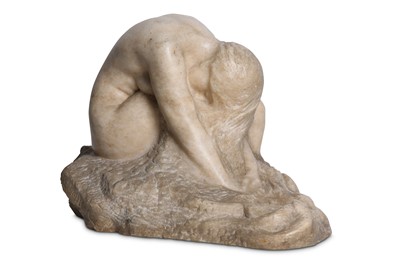6th Jun, 2018 10:00
Fine European Works of Art & Clocks
NAUM ARONSON (RUSSIAN 1872-1943): A WHITE MARBLE FIGURE OF SALOME, 'THE DESPAIR OF SALOME', CIRCA 1924 the nude figure on an integral rusticated base carved with numerous serpents, signed 'n. aronson' to the base, 23cm high x 36cm wide x 25.5cm deep On display at our South Kensington Gallery 17-30 May (on view at Chiswick from 31 May – 6 June) Provenance: Private Collection UK, acquired directly from the artist in Paris by Aaron Rapoport, and thence by descent. Aaron Rapoport was born in Moscow on May 18th 1878. He was the eldest son of the Rapoports: two cousins from a family of wealthy white Russian Jews living in Moscow: Berka Rapoport (born in 1847) and Perle married on April 4th 1874 and had 5 children. Towards the end of the 19th century, they fled Russia and sought refuge in France where they settled. Ary became naturalised French in December 1904. He was a diamond merchant and dealt in natural pearls in the office of “Rapoport Jerwood Perles et pierres fines” in the rue Drouot, in the 9tharrondissement in Paris. He lived in Rue Lauriston in the 16th arrondissement in Paris. They mixed with various artists, especially Russian Jews like themselves and Ary started collecting works by local painters and sculptors as well as English prints and etchings. He was a highly respected figure in the artistiic community and respected for his connoisseurship. He died in Paris in December 1963. Footnote: Naum Aronson was born in 1872 in the small town of Kreslavka, Vitebsk (formerly Russia, currently Latvia). He began sculpting at a young age. At sixteen he went to Vilna to study at Ivan Trutneu’s Drawing School for ten months, encountered anti-Semitism and returned to his hometown. In 1891 he moved to Paris, which was attracting East European Jewish artists at the time. For two years he simultaneously attended the free municipal Ecole des Arts Decorative, the class of the sculptor Prof. H. Lemarie, and the Privet Art School of F. Colarossi. He was influenced by the work of Michelangelo and Auguste Rodin (1840-1917) and he became acquainted with and deeply inspired by the work of the Impressionists. He lived and worked in Paris for nearly fifty years but due to financial difficulties, he was unable to attend the Ecole des Beaux Arts. He exhibited his work at the Salon du champs de Mars and he became a jury member of the salon. His work was also exhibited at the International Exhibition in 1900. He was awarded a gold medal prize in Liege. In 1937 he was granted France's highest award. the Legion of Honor, for his work at the 'Exposition Universelle.' Aronson reached his maturity in the 1920's, which is when the present marble dates from, and by this time he had exhibited a large body of works with such titles as Enigme, 'Les Épaves and Aux Innocents. They are similarly carved with forms emerging from a marble matrix left rough-hewn. The present work, one of his most emblematic and spiritual, relates to the bronze that was exhibited in 1924. This work may well show the influence of Rodin. He produced a number of versions of Salomé in bronze as well as another carved version in basalt which dated from 1837 and was acquired directly from the artist (see Sotheby's London: Tuesday, November 25, 2014 [Lot 505] Russian Works of Art, Fabergé and Icons). He was celebrated for his portrait busts of important leaders and cultural figures, including Beethoven, Wagner, Chopin, Berlioz, Pasteur, Tolstoy, Rasputin and Lenin (exhibited in the Soviet Pavillion in 1937). Aronson fled to America after the German invasion of France. He arrived in New York in March, 1941, on the S.S. Serpa Pinto, a Portuguese liner used by multiple Jewish organizations to transport refugees from Lisbon to New York. He died in New York in 1943. For further works from his collection including a study for the bust of Tolstoy by Naum Aronson, Arnold Borisovich Lakhovsky; Albert Abramovitz and Paul Jouve see Chiswick Auctions British & European Fine Art Sale 12th June 2018. We are grateful to Musya Glants, for her assistance in cataloguing this lot. Sources: Glants, M. Naum Aronson and Lev Tolstoi // Experiment / Эксперимент. A Journal of Russian Culture, v.1, p. 7-25. Charles Schlacks, Jr., Publisher, 1995. Musy Glants. Naum Aronson -- khudozhnik i chelovek. Paralleli: russko-evreiskii istoriko-literaturnyi almanakh, # 12, p.145-164. M: "Dom evreiskoi knigi", 2012. M. Glants. N. Aronson. Autobiography (materials from the Aronson's archive in New York). Vestnik evreiskogo universiteta v Moskve, # 2 (18), p. 278-304. Moskva-Yerusalim, 1998.
Sold for £7,000
Includes Buyer's Premium
Do you have an item similar to the item above? If so please click the link below to request a free online valuation through our website.









